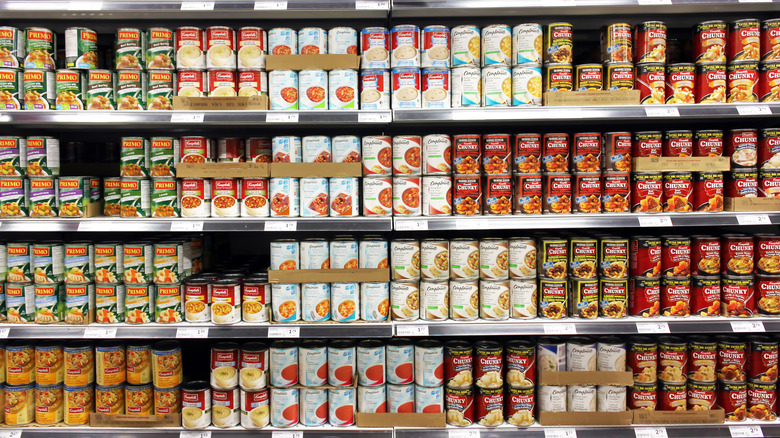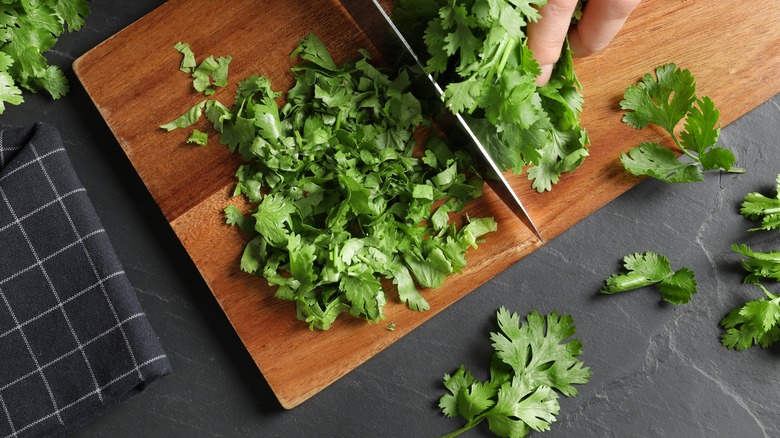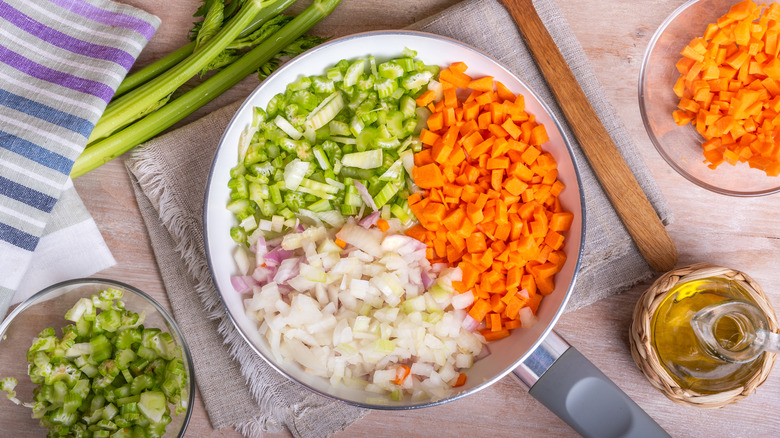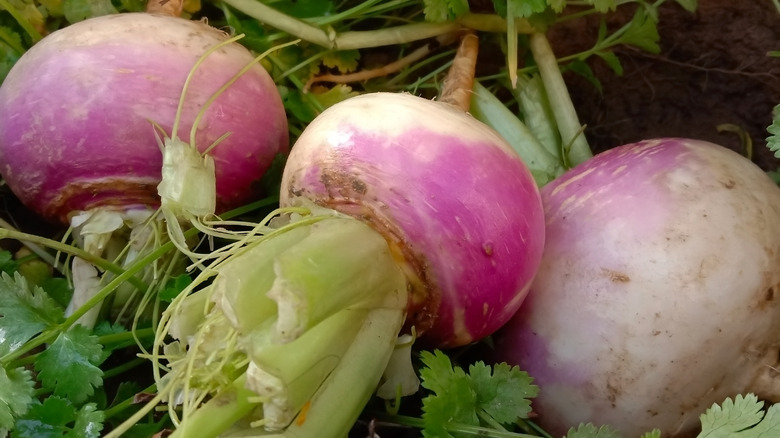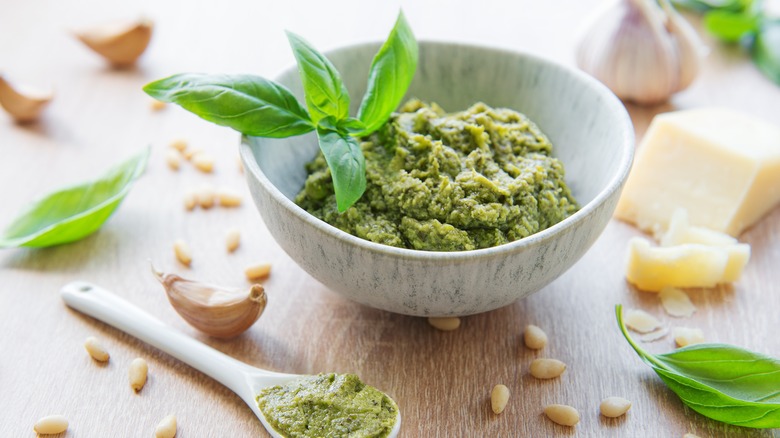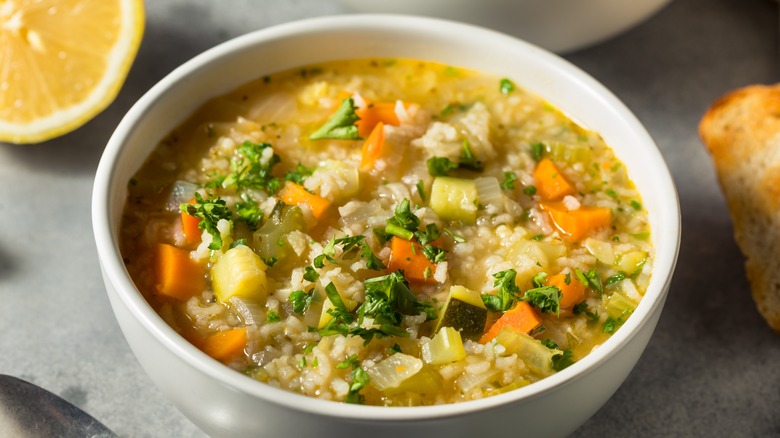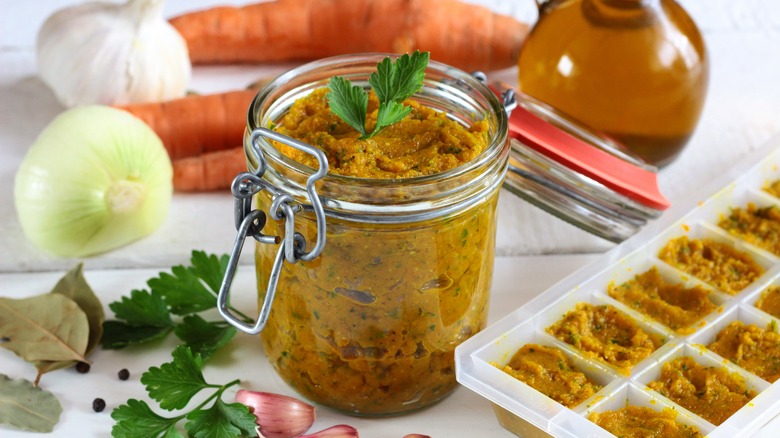A Beginner's Guide To Upgrading Canned Soup
We've all had it at some point. Whether it was a quick meal during a hurried lunch break, a creamy addition to a casserole, or a quick fix for a sick day as a child, canned soup is nothing new. However, you can turn this top item to keep stocked in your pantry into something out of the ordinary, unexpected, and altogether more delicious than what you've had in the past — all it takes is a few upgrades.
Elevating the contents of an ordinary can of soup doesn't need to be difficult or expensive. In many cases, it only takes adding a few fresh ingredients, some common pantry items you already have on hand, or even leftovers in your fridge. Any and all of these can all go a long way to taking a boring can of your average cream of chicken or bland tomato soup to something scrumptious and dinner-worthy. With a few tweaks, you might even find that you prefer the canned stuff to the (gasp!) homemade. Here are a few easy ideas for upgrading your next can of soup.
Add cheese
Start simple. There's no need to reinvent the wheel (or in this case, canned soup). While you can do a lot to a can of soup to make it better, sometimes you don't even have to do all that much. Cheese makes everything better, after all — so naturally, throwing on a sprinkling of your favorite kind can be a quick and easy way to improve your bowl of soup
If you have the time, there are some pretty inventive and delicious ways to incorporate cheese into your cup of tomato soup or cream of mushroom. If you're heating up a can of broth-based soup on the stove, consider tossing in a cheese rind as the soup simmers. It's not only a good way to use up leftover rinds (like those from hard cheeses such as parmesan or pecorino), but it also adds an amazingly rich, cheesy flavor to your broth. Just rinse your cheese rind and add it to the broth as things simmer along, and then remove the rinds before eating.
Add fresh protein
If you eat canned soup on the regular, you've likely run into some mystery meat. Sure, the can says it's chicken, but to the naked eye, it might resemble something more like a pink, gelatinous cube. Or maybe the can says it's beef, but in reality, the beige chunk in your dish looks anything but. Whatever the case may be, canned soup just doesn't always win in the protein department.
Speaking in an interview with the Greatist in 2021, Michelin star-rated chef Josiah Citrin explained that one of his favorite ways to upgrade canned chili is by purchasing vegetarian chili and then adding fresh protein at home. According to Citrin, not only is it a quick process (and very customizable, as you can add whatever protein you want), but it gives your chili a texture and flavor that it just can't get from the can alone.
You can do the exact same thing with any canned soup; just look for the vegetarian option and then cook and add your favorite protein right before you eat. No time to cook at home at all? Pick up a rotisserie chicken at the grocery store for a quick upgrade to your canned soup.
Add fresh herbs and spices
Every canned food can benefit from a fresh ingredient. While some canned soups do manage to remain flavorful long after they've reached the grocery store shelf, it can be difficult to replicate the taste of fresh food in an item that's intended to sit in a pantry for months (or even years, shudder). If you find your favorite canned soup is lacking a little fresh something, try adding some fresh herbs and spices. All it takes is a little chopping, grinding, or just shifting through your spice cabinet to find the right flavor fit.
Not sure what would go best with your soup of choice? Think about how you might make the same soup from scratch, and then add similar spices or herbs. For example, if you're heating up a can of spicy black bean soup, add in some chili powder, paprika, cumin, and red pepper flakes. Similarly, if you're heating up some minestrone, throw in some thyme and oregano, or some parsley in your average bowl of Campbell's can of chicken noodle.
Make a mirepoix
Even if you're not familiar with the term "mirepoix," you likely know what it is, even if not by name — there's even a chance you've used it many times if you're a seasoned home cook. In essence, mirepoix is a vegetable mixture that calls for two parts onions, one part celery, and one part carrots, per none other than Martha Stewart herself. Though not to be confused with the Holy Trinity — a similar mixture made of equal parts onions, celery, and bell peppers popular in Cajun and Creole — both mirepoix and the Holy Trinity are popular bases for soups and stews, lending aromatic flavors to dishes synonymous with comfort food cooking. So, if you're looking to upgrade an otherwise bland canned soup (looking at you again, chicken noodle!), consider starting with a mirepoix, or even the Holy Trinity.
Mirepoix can also be used to upgrade a basic boxed broth, to use in a pot for homemade soup, enhancing the broth flavor but expediting the process of blending those flavors together. Just chop your ingredients and simmer them in the bottom of a saucepan or soup pot until soft, and then pour in your canned soup or broth, and continue preparing your soup as normal — canned or otherwise.
Throw in a turnip
When you think of fresh veggies you could potentially add to upgrade your bowl of canned soup, you might think of onions, celery, spinach, green beans, or even corn — and there's a fair chance you wouldn't immediately think of the humble turnip. However, the turnip is exactly what celebrity chef Tyler Florence reportedly uses in his homemade chicken stock, an ingredient he praised in an episode of the Food Network show "Food 911" (via YouTube).
Turnips are root vegetables but possess their own distinct, unique flavor compared to, say, its cousin the potato. (The Masterclass website describes turnips as "milder than a beet," but "heartier and more versatile than a radish.") In celebrity chef Tyler Florence's chicken stock recipe, he allows his turnips to simmer alongside the chicken for over an hour — but there's no need for that amount of time if you want to upgrade your canned soup with this underutilized vegetable (via the Food Network). Instead, you can cook the turnips in your canned soup's broth for just about 10 minutes, and then remove them for eating separately, as one recipe recommended by the Food Network suggests.
Add milk or cream
If you already know you prefer creamy soups to those that are broth-based, then adding milk or cream to your canned soup is just a given. In a 2014 article, Spoon University writer Becca Berland recommended adding milk or cream to any soup that's on the creamy side already, like tomato soup or chowders, explaining that doing so can "add a fresh taste to a food that's been sitting on a shelf for several weeks (or months)." If you're going fully plant-based, coconut milk or cream, rather than its dairy counterpart, can also be a good addition to a canned soup for the same reason.
When adding a cold dairy liquid like milk or cream to a hot liquid like a simmering soup, there's one important thing to keep in mind: You want to be careful that you don't let the dairy curdle. To avoid this, it's recommended that you temper your milk by adding a small amount of the warm soup to your larger amount of desired milk, allowing the milk to slowly come to a warmer temperature. Then, once warm, add the milk to the soup. If your soup is already curdled, you can try to "shock" it back to normal by throwing in an ice cube, turning down the heat, and whisking heavily. You can also try running the curdled soup through a blender.
Add pesto, sherry, and croutons
Even celebrity chefs upgrade the odd can of soup every now and then, including the culinary writer and media personality behind The Pioneer Woman food blog. In 2020, Ree Drummond shared her favorite hack for upgrading a can of tomato soup – and while it's a little more complex than just throwing on a handful of cheese or splashing in some milk, you'll find your efforts for this upgrade are well worth it.
The Pioneer Woman's Tomato Soup 2.0 recipe uses your plain ol' average can of condensed tomato soup. According to Drummond, all you do is cook some jarred pesto in olive oil in the bottom of your soup pot, then add a few cans of condensed tomato soup and some water. After that, throw in some diced tomatoes, let it simmer, and then splash in some sherry or white wine. Season it all with parsley, salt, and pepper, and then top the mixture with parmesan and croutons for a soup upgrade that Drummond calls "something you'd eat in Paris ... if they have tomato soup in Paris." Don't want to make homemade croutons and don't like the bagged stuff? Drummond further recommends just using frozen Texas toast as a stand-in topping.
Add rice
Sometimes your canned soup isn't lacking so much in the flavor department — instead, its texture, not flavor, that leaves more to be desired. If that's the case, then rice has you covered. However, it's important to realize that you can't just toss in a cup of rice while your soup heats on the stovetop. You'll have to do a little thinking first.
According to the Livestrong Foundation, first, you have to decide whether you'll add cooked or uncooked rice to your canned soup. If you add cooked rice, things are simple. Just toss your rice in right before your soup finishes heating, giving the rice enough time to heat through. Don't add the rice too early in the cooking process, or you might overcook the rice.
If you decide to add uncooked rice to your canned soup, keep in mind that you'll have to add extra liquid, too, as the rice will soak up some of the existing liquid. (After all, you don't want to end up with a pot of all rice and no soup). Additionally, adding uncooked rice will also require extra cooking time. For the easiest soup upgrade, stick with the pre-cooked rice, either some leftovers from a past meal or store-bought pre-cooked rice that you can easily zap in the microwave. (And don't forget to sing along to Carol King's "Eating Chicken Soup with Rice" if you decide to go that route!)
Add eggs
You might be familiar with egg drop soup, but that's not the only soup that's delicious once you add an egg or two. Eggs can lend texture and richness to broth-based soups, like chicken vegetable, with ease. And while getting those wispy egg whites to look and taste just right can seem difficult to achieve if you've never made egg drop soup before, it's actually not that difficult at all.
As OMG Hospitality Group's executive chef Daniel England noted in a 2021 interview with Insider, you should have your egg or eggs on standby as you finish up your soup — or, in this case, heating your soup on the stovetop. As soon as you remove the soup from the heat, crack the egg directly into the soup while you stir, quickly and constantly. The egg cooks almost immediately and you know it's done when the egg white turns ... well, white.
If you want to explore adding egg to your soup, you can go a little retro with some recs from this 1986 article published by The New York Times. Specifically, the piece suggests poaching an egg and then serving it atop the soup directly, or atop a crouton. And don't forget a nice bowl of Roman stracciatella, either.
Add bouillon paste
If you've forever relied on cubed or powdered bouillon, your mind is about to be blown by the flavor-heavy, umami wonder that is bouillon paste. One of the most popular bouillon paste brands is Better than Bouillon, which offers a line of products that are made from meat, vegetables, and spices, but with less salt than its traditional bouillon counterparts. A number of chefs use bouillion for a variety of dishes; beloved author, media personality, and chef Anthony Bourdain even waxed poetic about the ingredient in his 2002 memoir "Kitchen Confidential: Adventures in the Culinary Underbelly" (via The Kitchn). As Bourdain noted in one "Kitchen Confidential" passage, his classmates in culinary school couldn't "figure out how I coaxed such hearty flavor out of a few chicken bones, or made such wonderful fish fumet with fish racks and shrimp shells, all in the limited time available"; as you might have guessed, the secret was bouillon. If it's good enough for Anthony Bourdain, it's good enough for us.
Adding a touch of bouillon paste to your canned soup can take that canned broth to a whole new level. Just make sure that you match your paste to your broth (so chicken paste in a chicken broth-based soup and so on). Start with only a little bouillon paste at first, then gradually add more and taste as you go; it can pack a punch, and you don't want to add too much.
Add nutritional yeast
An ingredient known for its umami flair and (substitutional) cheesy appeal, nutritional yeast is a popular vegan addition to pasta, popcorn, and more. In fact, it's become a go-to for just about any dish that needs a bit more flavor, but without any animal byproducts. In addition to being vegan, nutritional yeast is also filled with vitamins and nutrients such as potassium, calcium, niacin, amino and folic acids, and vitamins A, B12, C, and B6 (via MasterClass). Best of all for soup-lovers, you can also add nutritional yeast to your soups — for both flavor and for some added texture.
If you're just adding nutritional yeast to your soup for flavor, you can add a teaspoon or two near the end of the cooking process, taste it, and then add a little more if needed. If your objective is to thicken your soup while ascertaining a creamier texture sans dairy, you can add two or more tablespoons of nutritional yeast per two cups of soup. To ensure the nutritional yeast retains as much of its nutritional properties as possible, try to keep it away from a hot stovetop while mixing it in.
Add some acid
If you're heating up a can of a chicken broth-based soup, then there's one ingredient you need to retrieve from your produce drawer: a fresh lemon. No matter what type of chicken broth-based soup you're making, the publication says, lemon can help add much-needed brightness and freshness to a dish that can otherwise be a bit dull and salty. Think of the way an acidic vinaigrette adds a new depth of flavor to a simple salad; a lemon in your chicken soup can act much the same way. (Here's another way to put it: Think like "Salt, Fat, Acid, Heat" author and the Netflix adaptation's star chef Samin Nosrat.)
If you want to use a lemon in your soup, add a squeeze of lemon juice only after you've portioned the soup into your bowl. You don't want it heated. In addition to this, consider removing the seeds from your lemon before squeezing, so you don't inadvertently end up with seeds in your soup. And if you're all out of lemons but have a few limes on hand, you can use them in the exact same way as the former — especially if you're heating up Mexican or Asian-inspired canned soups.
Use your canned soup as a starting point
Don't think that your simple can of soup is where this game begins and ends. You're not limited to only adding one or two ingredients to your pre-canned goods and calling it a day. Instead of leaving your canned soup more or less what it is, consider transforming your canned soup into an entirely new dish.
There are lots of complex soup (and other) recipes that require canned soup as a base. For example, you can mix up this easy slow cooker chicken and dumplings recipe that starts with one can of cream of chicken soup, then adds in fresh veggies, chicken, and spices. You can also break out the Instant Pot to make this cowboy stew with ranch-style beans; it starts with canned tomato soup and then adds cans of tomatoes, beans, and chiles, alongside kielbasa, spices, and ground beef. There's also the option of transforming your canned soup into a totally different meal of the non-soup meal variety. From cakes to enchiladas to hash brown casserole, you might just be surprised at how many recipes that use a can of soup exist out there in the big wide world.
